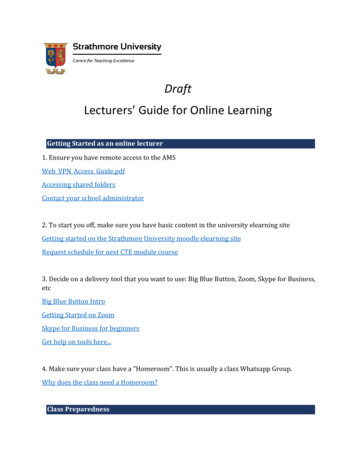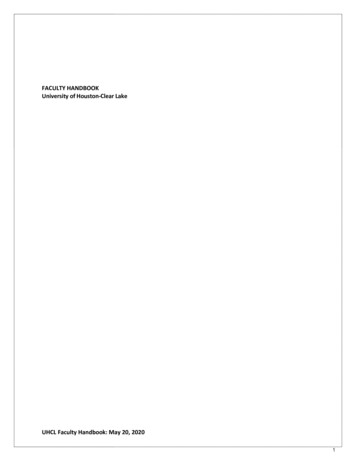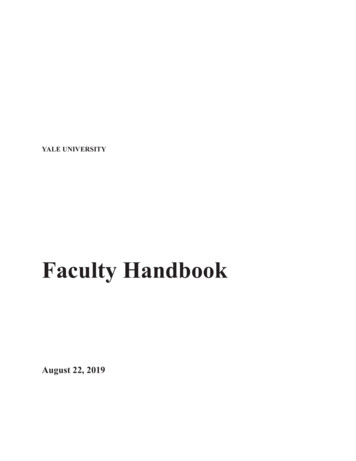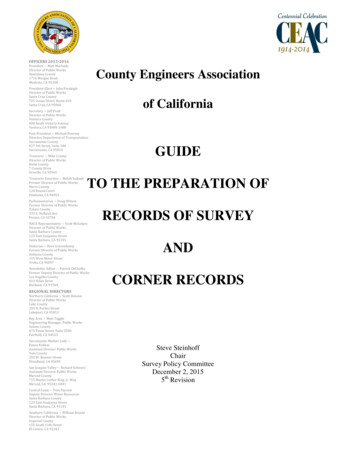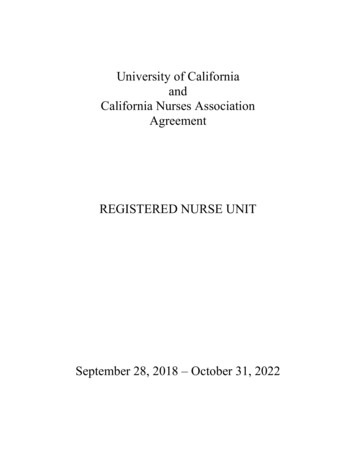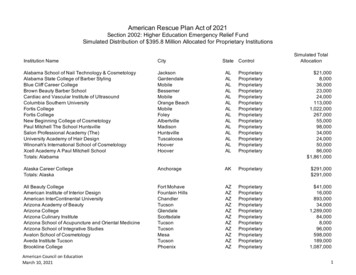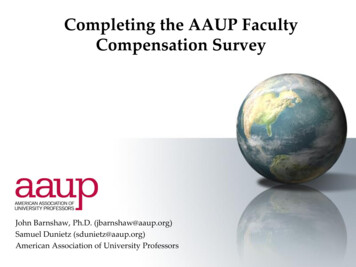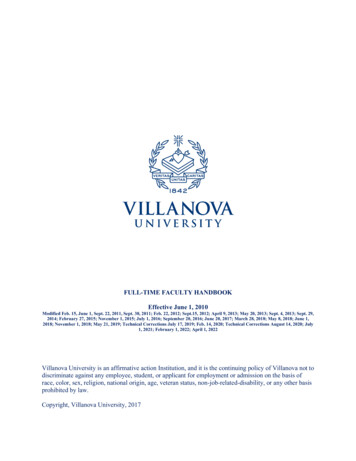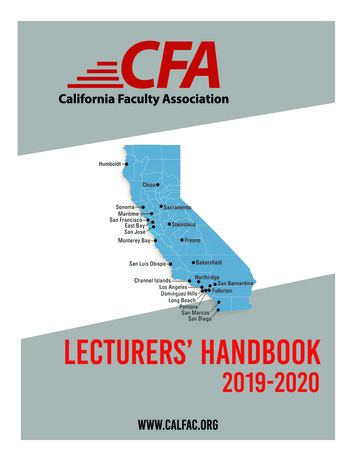
Transcription
Lecturers’ handbook2019-2020www.calfac.org
Updated July 2019Please see the CFA Lecturers’ Councilweb site for updates to this Handbookwww.calfac.org/lecturers-councilThis CFA Lecturers’ Handbook provides a general discussionof the faculty contract. The contract itself is posted on the CFAstatewide website at www.calfac.orgTo receive a printed copy of the contractor to discuss the meaning of any of its provisions,contact your campus CFA Lecturer Representative,your local CFA chapter, or the CFA staff person on campus.Exercise care in interpreting provisions of the Contract.Provisions in one section may be affected by languagein another section or by arbitration decisions that do not explicitlyappear anywhere in the body of the contract.More information is available atwww.calfac.org/lecturers-council2 2019-2020 CFA Lecturers’ Handbook
WELCOMEThis 2019-2020 edition of the CFA Lecturers’ Handbook comes to you through theefforts of your California Faculty Association Lecturer colleagues. It will give you anoverview of your rights as a Lecturer faculty member in the California State Universitysystem, plus specific information on how to exercise and defend those rights.This Handbook does not contain the entire Collective Bargaining Agreement betweenCFA and the CSU, but it does reference relevant provisions in order to offer authoritativeinformation about a wide variety of situations a Lecturer may encounter while working forthe CSU.The Handbook also includes the results of some key grievance decisions, benefits provisionsdetermined by statutes and by other agencies, and other rules and practices that structureour work environment.As a convenience, the Lecturers’ Handbook is available online from the CFA Lecturers’ webpages at www.calfac.org/lecturers-council. To find the name of your campus CFA LecturerRepresentative, go directly to www.calfac.org/lecturers-council-representativesBy staying informed and working together, we can build a Lecturer community that supportsour chosen work and protects the quality of our professional lives.In Solidarity,Charles Toombs, CFA PresidentLeslie Bryan, CFA Associate Vice President for Lecturers-SouthMeghan O’Donnell, CFA Associate Vice President for Lecturers-North2019-2020 CFA Lecturers’ Handbook 3
CONTENTS6Part 1: The Work Environment CFA: A Brief History of Our Faculty Union Lecturers in the CSU10Part 2. The Collective Bargaining Agreement13Part 3. Employment1829 Your Employment Records Appointment Letter (Article 12) Personnel Files (Article 11) Evaluation (Article 15) Reapointment and Careful Consideration (Articles 11, 12, 15) Job Security: One-Year and Three-Year Appointments (Article 12) Extension Work (Article 40)Part 4: Compensation Salary (Article 31) Benefits Unemployment BenefitsPart 5: Leaves Paid Leave Unpaid Leave31Part 6: Grievances and Other Problems34Part 7: Organizing39Part 8: Toward Better Conditions for Teaching & Learning41Part 9: CFA Membership43Part 10: The CFA Lecturers’ Council45Part 11: Anti-Racism and the Social Justice Transformation of CFA46Appendix A: CFA Bylaws Provisions48Appendix B(1): CSU Salary Schedule for ‘Lecturer—Academic Year’49Appendix B(2): Chart of the Lecturer Salary Schedule50Appendix C: Glossary4 2019-2020 CFA Lecturers’ Handbook
INTRODUCTIONIn November 2014, the membership of the California Faculty Association (CFA) and the Board ofTrustees of the California State University (CSU) ratified a new Collective Bargaining Agreement (CBA)for the years 2014-2017. We settled on salary for the 2014-15 academic year, but not for the two outyears of 2015-16 or 2016-17.In Spring of 2016, we came within a week of a 23-campus systemwide strike, and as a result we wereable to bargain: a 5% General Salary Increase (GSI) effective on June 30, 2016a 2% GSI effective the next day on July 1, 2016a 3.5% GSI effective on July 1, 2017a 2.65% Salary Service Increase (SSI) in 2017-18Plus, we negotiated a three-year alternative method of Lecturer Range Elevation eligibility for long-termLecturers that was not dependent on their reaching the SSI maximum of their current salary range.We also extended this CBA to June 30, 2018.In Summer of 2017, CFA was approached by the CSU Chancellor’s Office about an extension to our CBA.By the end of that Summer, we had agreed on a two-year extension until June 30, 2020, that includes: a 3.5% GSI on November 1, 2018 a 2.5% GSI on July 1, 2019Because of the hard work of our CFA Bargaining Team, which includes Lecturers, Tenure-line faculty,Librarians, Coaches and Counselors, we were able to preserve important protections and rights in ourContract and achieve a number of improvements.It is important to understand, however, that the Contract is an organic document and, as such, often isimpacted in significant ways by actions of the two parties and by arbitrations decided by third parties.Thus, it is advisable that Lecturers stay informed about the Contract and participate in the faculty rightsprocess on our respective campuses.The entire 2014-2020 Contract is available on the CFA website atwww.calfac.org/2014-2020-contractOne of the roles of the campus CFA Lecturer Representative is to communicate changes that occur in theinterpretation or implementation of the Collective Bargaining Agreement. For the name of your campusCFA Lecturer Representative, visit the CFA website at lifornia Faculty AssociationLecturers’ Council(916) 441-4848www.calfac.org/lecturers cfa@calfac.org2019-2020 CFA Lecturers’ Handbook 5
1. The Work EnvironmentTAbout the CSUhe California State University (CSU), the largest fouryear higher education system in the nation, comprises23 campuses that serve all regions of the state. Itseducational programs grant its students degrees, credentials and certificates in the liberal arts and sciences, aswell as in certain applied fields and professions. Though itawards some terminal degrees, including in limited doctoralprograms, the CSU is dedicated primarily to undergraduateeducation.Currently, the CSU enrolls some 480,000 students. Approximately 28,000 faculty members engage in teaching,research, creative activities, and service to the community.Lecturers are over 59% of the faculty on most campuses andin the system as a whole.As a state-supported institution, most, but not all, fundingfor the CSU comes from the State of California. The governor and the legislature of the state exercise considerableinfluence over the CSU through the annual budget processand through the appointment of the members of the CSUBoard of Trustees.The Board of Trustees appoints the Chancellor to whom allcampus presidents report. In 2012, Timothy White replacedCharles Reed as Chancellor. The Chancellor’s Office, locatedin the City of Long Beach, also serves as the headquartersfor the Board of Trustees and for the statewide CSU Academic Senate.At the campus level, faculty participate in shared governance through campus senates, which typically includestaff and student representatives as well. Campus senatesare advisory to campus presidents, who may or may notadopt senate policy recommendations. The statewide CSUAcademic Senate is a recommending and consultative bodyto the Chancellor. While there is no reserved position forLecturers on the statewide CSU Academic Senate, Lecturershave served in this body in the past and there recently havebeen two Lecturers serving on the CSU Academic Senate —Karen Davis (Monterey Bay), who recently retired, and JohnYudelson (Channel Islands) who still serves.Lecturers are eligible to serve on most campus senates,but not all. Each campus determines whether Lecturers areeligible to serve on its senate or to represent the campus onthe statewide senate. On some campuses, Lecturers holddesignated (at-large) Lecturer seats and are elected by aconstituency of Lecturers on their campus. Other campusesallow Lecturers to hold non-designated seats, representingtheir departments or colleges like any other elected senator6 2019-2020 CFA Lecturers’ Handbookand elected by the general faculty.Lecturers on many campuses have been working with CFAand senate activists to initiate and/or increase Lecturerparticipation on the senates, which craft many of the policies that affect Lecturers. For the purpose of helping theseactivists enhance Lecturer voice in shared governance, byrequest from the Lecturers’ Council, CFA has establishedtwo Lecturer sub-committees, on Governance and on Lecturer Evaluation. Current co-chairs of these sub-committeesinclude Chris Nagel (Stanislaus), and Mark Karplus (EastBay).For additional information on the CSU and the statewideCSU Academic Senate, consult www.calstate.eduCFA: A Brief Historyof Our Faculty UnionIn the early 1980s, after more than a decade of competitionamong several faculty unions, CFA emerged as the exclusivebargaining representative for Unit 3, which is all CSU faculty, including Librarians, Coaches and Counselors.In the early 1960s, faculty on various campuses began toform union locals, and by the early 1970s they had established two competing unions to defend their rights andadvance their professional and economic interests. TheUnited Professors of California (UPC), founded in 1970,was affiliated with the American Federation of Teachersand its California organization, the California Federation ofTeachers.Founded four years later, the Congress of Faculty Associations (CFA) was affiliated with the American Association ofUniversity Professors (AAUP), the National Education Association (NEA), the California Teachers Association (CTA) andthe California State Employees Association (CSEA).In 1978, the state legislature passed the Higher EducationEmployer-Employee Relations Act (HEERA), which enabledthe CSU faculty to elect a systemwide collective bargainingrepresentative. The faculty’s overwhelming support for collective bargaining was prompted by concerns about erodingsalaries, increasing bureaucratization of the CSU, and theneed for an advocate committed to quality higher education.In 1982, after two narrow elections in which 85% of thefaculty voted for some form of collective bargaining, CFAwas chosen by CSU faculty as the exclusive bargaining agent
for the faculty and the union was certified by the PublicEmployment Relations Board (PERB). Soon thereafter, CFAbecame the California Faculty Association and added anaffiliation with the Service Employees International Union(SEIU). Finally, UPC and CFA merged and activists from bothunions joined together in order to form the strongest possible advocate for the faculty.Lecturers played an active role in both unions and in bothelections. We have become an important constituency inCFA, which guarantees special representation to Lecturermembers in union affairs and governance. For example, theCFA Bylaws call for specific Lecturer representation at theCFA Assembly (which is the statewide governing body anddirect representative of members), among the statewideCFA Officers (of which two are the AVPs of Lecturers), onthe Board of Directors (BOD) (which oversees the governance and carries out the policies of CFA), and on allstatewide committees (such as Political Action/Legislation,Representation, and Membership & Organizing).To adequately address the concerns of Lecturer facultyduring contract negotiations, Lecturer Representatives sit onthe CFA Bargaining Team and the Contract Development/Bargaining Strategy Committee (CD/BS). At times, Lecturershave chaired CFA committees, including the CD/BS Committee. Currently, Antonio Gallo, Lecturer Representativeat CSU Northridge, is chair of CD/BS. Due to a recent CFABylaws change, the number of Lecturers serving on the CFABoard of Directors has increased by two for a total of six.At the campus level, a CFA executive committee or boardprovides leadership and advocacy for all faculty membersand includes a Lecturer Representative as one of the chapterofficers and voting members at CFA assemblies. Informationabout local chapters is available from their websites, whichcan be found at www.calfac.org/campus-cfa-chaptersIn 1983, CFA and the CSU administration negotiated thefirst collective bargaining agreement (CBA, also often referred to as MOU, Memorandum of Understanding or theContract). The current 2014-2020 Contract is CFA’s tenthagreement with the CSU.To bargain contracts and protect faculty rights under theContract, CFA is funded by faculty who are CFA members.The union has the legal duty, known in labor law as the“Duty of Fair Representation,” to represent all faculty fairly.From the outset, CFA has fulfilled its duty with hard workand dedication, much of it by volunteer faculty activists,including Lecturers.For more information on HEERA, seewww.perb.ca.gov/laws/heera.aspFor information on the 1981 PERB decision to place bothtenure-line and Lecturer faculty in the same collective bargaining unit (Unit 3), er to Appendix A of this Handbook to see excerpts of therelevant CFA Bylaw provisions on Lecturer representationand roles in the union’s governance structure.Lecturers in the CSULecturers currently constitute over half of the approximately28,000 CSU faculty. Employment data from recent yearssuggests important trends in the employment of Lecturerswithin the CSU. Since the budget cuts in the 1990s, theproportion of Lecturers relative to all CSU faculty has beenincreasing steadily, from about 37% in November 1991 toover 59% at present, reflecting a nationwide trend.Lecturers are faculty who have term appointments thatrange from one quarter or semester to several years inlength and that are usually conditional on budget and enrollment. Faculty appointed as three-year full-time Lecturershave unconditional appointments. Because all Lecturershave temporary, non-tenure-track appointments, the CBArefers to Lecturers as “temporary faculty.” On some campuses and in many departments, Lecturers outnumber tenuredand tenure-track faculty by a considerable margin.Currently, about 61% of CSU Lecturers teach 6 units ormore, a 0.4 time base or greater, per semester or quarter(every 3 units a 0.2 time base). About 17% are teaching 15units, a 1.0 or full-time base, per semester or quarter. Thetime base at which Lecturers are employed is critical because, among other things, it determines eligibility for healthand retirement benefits. (See Part 4: Compensation.)Another important aspect of Lecturer employment is thelarge number of Lecturers who, despite their nominal “temporary” status, work in the CSU system for long periods oftime. Available data indicates that over half of all currentLecturers were first appointed more than five years ago,and a cohort of Lecturers (around 11%) was first appointedover 20 years ago. Thus, the CSU depends on many of thesame Lecturers year after year though, in bargaining, theCSU administration often resists proposed improvements inLecturer job security.Rich Moser, a former Associate Secretary of the AmericanAssociation of University Professors, has analyzed the trendtoward the replacement of tenure-line faculty by temporaryor “contingent” faculty across the United States and Canada.In his article entitled, “The New Academic Labor System,Corporatization, and the Renewal of Academic Citizenship,”Moser explains this replacement of tenure-track by nontenure-track faculty as central to the corporatization of theuniversity and, thus, as a threat to academic freedom.The most striking symptoms of corporatization are: Concentration of university resources on areaswhere wealth is created;2019-2020 CFA Lecturers’ Handbook 7
Marginalization of the liberal arts and all areas ofresearch not conducive to the creation of wealth; Increase in corporate funding and control over academic research; Entitlement of the corporate sector to new ideas andtechnologies developed at public cost; Privatization and outsourcing of university functionsand jobs from food services to bookstores to instruction; Increase in authoritarian governance practices; Rise in tuition and debt loads for students; Stagnant wages for tenure-line faculty and povertywages with low or no benefits for all other universityworkers.Moser’s article is available at In spite of the considerable obstacles and little support fromthe CSU administration for the professional developmentof over half the faculty, most Lecturers exhibit a profile verysimilar to that of tenure-line faculty. Many have terminal degrees, do research and/or creative work, publish, participatein conferences, develop new courses, remain current in theirfields, advise students, and carry out important communityservice. As reported in the 2006 AAUP Contingent FacultyIndex:The central problem of contingent academics is not thepeople who fill these positions, as they are most oftenable teachers and scholars forced into these positionsby the structure of academic employment. The problemlies in the nature of contingent work, its lack of supportstructures and the constraints on academic freedom for8 2019-2020 CFA Lecturers’ Handbookfaculty in these positions. (Page 6, John W. Curtis &Monica F. Jacobe, available at all/aaup-contingentfaculty-index-2006)In an effort to improve our physical, economic, and intellectual conditions of work, Lecturers have become increasinglyinvolved in CFA and on statewide and campus senates. Asa result of Lecturer organizing and participation in CFA, inthe 2002-2005 Contract we won the right to three-year appointments and in subsequent agreements have enhancedand clarified appointment rights. Lecturers who have taughtat least one semester or two quarters for six consecutiveyears in a single department receive three-year appointments as long as there is work available for which they arequalified.Initial and roll-over three-year appointments are issuedautomatically to eligible Lecturers with satisfactory periodicevaluations and a satisfactory six- or three-year cumulativeevaluation. In addition to the three-year appointment thereis a “Preference for Available Temporary Work” requiringthat “new or additional work” be offered first to three-yearpart-time Lecturers, and then to one-year part-time Lecturers, before new Lecturers may be hired.This presumption of reappointment and opportunities forLecturers to increase their time base up to full time significantly enhances employment stability for CSU Lecturers.The improvements in Lecturer working conditions sought byCFA in contract negotiations reflect the union’s position ofresistance to the central administration’s efforts to corporatize the CSU. (See Part 3: Employment for more specifics onLecturer appointment rights and evaluation procedures.)For an overview of faculty who are tenured/tenure-track versustemporary (full-time equivalent and headcount), see charts onfollowing pages.
2019-2020 CFA Lecturers’ Handbook 9
2. The Collective Bargaining AgreementThe terms “CBA” (Collective Bargaining Agreement)and “MOU” (Memorandum of Understanding) bothrefer to the statewide Contract negotiated betweenCFA and the CSU. In addition to the faculty, the CSU alsoenters into collective bargaining agreements with all nonadministrative employee units (police, doctors, and studentemployees, as well as administrative, technical and custodialstaff). The Contract for the faculty (Unit 3) describes theterms and conditions of employment for all teaching faculty,Counselors, Librarians, and Coaches.there is sufficient work available. The one-yearappointment and the time-base entitlement notonly provide greater job stability for Lecturersbut also help many part-time Lecturers qualify forhealth and retirement benefits. After teaching one semester or two quarters in eachof six consecutive years in a department, Lecturersreceive three-year appointments at their currenttime-base entitlement. Initial and roll-over threeyear appointments are issued automatically toeligible Lecturers who have received a satisfactorycumulative evaluation and have no documentedserious conduct problems. Entitlements in subsequent three-year appointments are determined bythe time base during the third and final year of theprevious appointment. Since the early 1980s, CFA Lecturers have worked toactively defend our rights and improve our employmentconditions. The improvements in the recent Contractbuild upon gains in previous contracts and upon ideas,discussions, participation, and activism of Lecturers in thecollective bargaining process over the years. Followingare some key historical improvements, items that will bediscussed in some detail later in this Handbook.Lecturers seeking three-year appointments will beevaluated on their cumulative work performanceduring the qualifying period (six years forinitial appointments, three years for repeatingappointments), protecting against a negativeevaluation based on insufficient evidence. The first CFA-CSU collective bargaining agreement (1983)laid the foundation for Lecturer appointments, which arebased on the following provisions:If there is no work available to satisfy a Lecturer’stime-base entitlement during any academic term ofa three-year appointment, the Lecturer continuesto maintain the entitlement for the duration of thethree-year appointment. Lecturers with three-year appointments have theright to be placed on a department reemploymentlist under the following circumstances:In the CBA, full-time non-tenure-track and part-timenon-tenure-track faculty are referred to as “Lecturers”in the salary schedule and as “temporary faculty unitemployees” (either part time or full time) within the bodyof the document. Articles 12, 15, 31, and 32 along with thesalary schedule contain most of the important provisionsgoverning the terms and conditions of employment forLecturers. However, relevant provisions may be found in anumber of other articles in the Contract. Departments must maintain lists (or pools) ofLecturers who have been evaluated previously andprovide these Lecturers with “careful consideration”for subsequent appointments. Lecturers appointed to a similar assignment inthe same department in consecutive academicyears must receive the same or higher salaries aspreviously. The “similar assignment” language is thebasis of the notion that Lecturers have an entitlement to a certain time base when they are rehired.Negotiations of subsequent contracts have resulted in thefollowing advances: Part-time Lecturers who are re-hired after twosemesters or three quarters of consecutiveemployment within an academic year must receiveone-year appointments at the same time base(number of units) as that of the previous year, if10 2019-2020 CFA Lecturers’ Handbook if at the end of a three-year appointmentthere is no work available, or there is nowork available to support an initial three-yearappointment, or if a Lecturer has a zero time base during thethird year of an appointment, or if during the course of a three-yearappointment the Lecturer is laid off. Lecturers are given their assignments according to a“Preference for Available Temporary Work” outlinedin Article 12.29 of the Collective BargainingAgreement. Lecturers must be compensated for all workassigned, including work in excess of full time (15units). In the past, Lecturers were not guaranteedpayment for a 16th unit. Lecturers in the CSU receive General SalaryIncreases (GSIs) at the same percentage level as
tenure-line faculty, a notable exception to theexperience of most contingent faculty. Lecturers also have the right to receive ServiceSalary Increases (SSIs) after teaching 24 weightedteaching units (WTUs) in the semester system or 36WTUs in the quarter system in the same department or unit (when SSIs are negotiated) up to theSSI maximum for their range (Lecturer A, B, C, D). Lecturers who have been in their range for fiveyears and are at the SSI maximum for that rangehave the right to apply for a Range Elevation, that is,to move from Range A to B, B to C, or C to D. Lecturers possessing terminal degreesappropriate to teach in the discipline must beappointed in Range B or higher. If prior to the third class meeting, a class iscancelled or if the Lecturer is bumped fromteaching a class by someone with higherpreference for work, the Lecturer will be paidpro-rata for the portion of the course sincethe official start date of that term. If a Lecturerloses a class for any reason after the third classmeeting, the Lecturer will be paid in full for theclass.See an overview of provisions in the CollectiveBargaining Agreement that are particularlyrelevant to Lecturers in the Quick Guide on thefollowing page.2019-2020 CFA Lecturers’ Handbook 11
Quick Guide to Lecturer Provisionsin CFA/CSU Collective Bargaining Agreement (CBA) 2014-2020This quick guide refers you to CBA articles with provisions that are particularly relevant to Lecturers(faculty on full- or part-time temporary appointments). The CBA is available at www.calfac.org.Getting and Keeping the Work12.212.312.512.5, .524.1-24-2338.11-38.1211.110.210.27-10.28Appendix FAppointment lettersOne-year appointment rights and entitlement rights (also see chart in Appendix F)Pay for classes canceled prior to third class meeting/subsequent cancellations require full payFull-time non-contingent appointment rightsCareful considerationSimilar assignment and salary placementThree-year appointments, including zero time base to protect entitlement (12.12.e)Re-employment rights (see also Article 38.48)Subsequent three-year appointmentsPreference for available work (order of assignment) up to and including a 1.0 time baseCompensation for the 16th unitRestrictions on Visiting Faculty employmentEvaluation procedures (including student evaluations of teaching)Classroom visits require notification and consultationPeriodic evaluation requirements for Lecturers with three-year appointmentsContractual procedures and hiring order for state-funded summer termLeave of absence without pay (Lecturer entitlements protected in 22.2)Paid parental leave (Article 23 covers additional paid leaves)Paid sick leave, disability leave, and catastrophic leaveOrder of layoff (see also re-employment rights in 38.48)Personnel files as basis for personnel actionsLecturers have full access to grievance procedures: both contractual and statutory tracks.Expedited umpire arbitration procedure for Lecturer appointment casesChart of eligibility criteria for one-year and three-year appointmentsGetting a Fair Salary31.1-31.631.731.17- dLecturers on same salary schedule as tenure-line faculty (except Range A only for Lecturers)Lecturers receive same percent General Salary Increase as tenure-line facultyLecturers receive same percent Service Salary Increases (SSIs) as tenure-line facultyReappointment in same department or unit requires same or higher salary placement.Lecturer SSI eligibility 24 WTUs at semester campus or 36 WTUs at quarter campusAbility upon new appointment to be rehired above SSI maximumRange Elevation to allow advancement on salary schedule (with appeal rights)Criteria for Range Elevation shall be appropriate to Lecturer work assignmentsNotification of Range Elevation eligibility requiredDedicated department funding sufficient to implement contractually required increasesPart-time Lecturer compensated at regular rate of pay for all WTUs assignedGetting Benefits32.232.1321.2832.19In statutenot CBA26.1-26.14Full health benefits (medical, vision, dental, disability, life insurance) for Lecturers and coaches with atleast 6 units (a 0.4 time base) per term and appointment for at least one semester or two consecutive quartersFlex cash payments for benefits-eligible faculty who waive benefitsLecturer benefits stipend in summer term (see criteria)PST Retirement Plan for Lecturers not eligible for CalPERS retirement planLecturers with at least 7.5 WTUs enrolled in CalPERS and social security (with employee and employer contributions) atbeginning of third semester or fourth quarter of consecutive employment at 0.5 (7.5) WTUs or higherLecturers and Coaches eligible for fee waiver (see criteria in 26.1)Equal Access/Recognition as a Faculty Member in the 3.327.2, 28.4Part-time and full-time faculty on temporary appointments are faculty unit employees in Unit 3 covered by allreferences in the CBA to “faculty” unless specifically excluded.In statutory grievance process, all full-time Lecturers serve on panels and can serve on committees. (Service byLecturers is voluntary.)Lecturers eligible for Assigned Time for Exceptional Levels of Service to StudentsRight to notification of total accrued sick leaveLecturers eligible to apply for and receive RSCA (Research, Scholarly and Creative Activity) AwardsAccess to direct deposit programAccess to pre-tax parking and one parking pass for multiple campusesAccess to personal holidayFull-time Lecturer eligibility for sabbatical and difference-in-pay leaves12 2019-2020 CFA Lecturers’ Handbook
3. EmploymentYour Employment RecordsCFA recommends that Lecturers keep a carefullymaintained file of documents pertaining to theiremployment in the CSU. In order for CFA to helpprotect your rights, it is critical that you stay informed aboutyour employment status. Important documents to consultinclude your original appointment letter.The following information is important to keep for yourrecords: All your appointment letters; Date of your first Lecturer appointment; Date of your most recent hiring and/or durationof your current appointment (semester, quarter,academic year, or multiple year); The time base for your current appointment; The total cumulative number of weighted teachinguni
CFA, which guarantees special representation to Lecturer members in union affairs and governance. For example, the CFA Bylaws call for specific Lecturer representation at the CFA Assembly (which is the statewide governing body and direct representative of members), among the statewide CFA Officers (of which two are the AVPs of Lecturers), on
